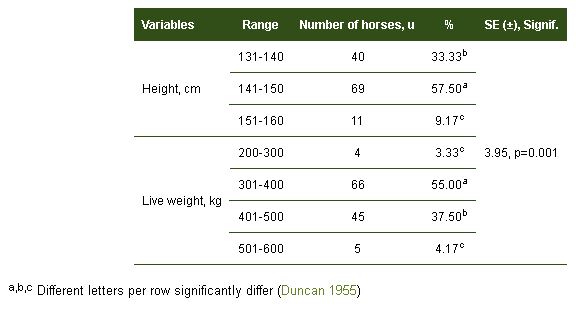Evaluation of live weight and height in draft horses (Equus caballus) and their relation with animal welfare
Main Article Content
Abstract
A total of 120 horse- drawn cart were randomly selected in San José de las Lajas municipality, Mayabeque, Cuba, to evaluate height and live weight, as well as the relation of these indicators with animal welfare. A tape measure was used to measure the height, chest circumference and length from the ischial tuberosity to the tip of the horses shoulder. The data from these last two indicators were used to calculate the thoracic circumference of each animal. The results obtained from the height and live weight were subjected to statistical analysis and compared with the parameters recommended for carrying out heavy work such as horse-drawn vehicles. Of the sampled horses, 33.33 % showed heights below the required 140 cm. More than 55 % of the animals did not fulfill with the established 500 kg body weight. The questionnaires performed to the owners revealed that of the 37 horses in the development stage, aged between one and five years, six were below the three years required for working tasks, and there is no control over the kilograms of load they can drawn, according to their biometric parameters. It was concluded that the biometric parameters in the horses-drawn evaluated were not fulfill by a significant amount, which is detrimental to their welfare.
Article Details

This work is licensed under a Creative Commons Attribution-NonCommercial 4.0 International License.
Those authors that have publications with this journal accept the following terms:
1. They will retain their copyright and guarantee the journal the right of first publication of their work, which will be simultaneously subject to the License Creative Commons Attribution-NonCommercial 4.0 International (CC BY-NC 4.0) that allows third parties to share the work whenever its author is indicated and its first publication this journal. Under this license the author will be free of:
- Share — copy and redistribute the material in any medium or format
- Adapt — remix, transform, and build upon the material
- The licensor cannot revoke these freedoms as long as you follow the license terms.
Under the following terms:
- Attribution — You must give appropriate credit, provide a link to the license, and indicate if changes were made. You may do so in any reasonable manner, but not in any way that suggests the licensor endorses you or your use.
- NonCommercial — You may not use the material for commercial purposes.
- No additional restrictions — You may not apply legal terms or technological measures that legally restrict others from doing anything the license permits.
2. The authors may adopt other non-exclusive license agreements to distribute the published version of the work (e.g., deposit it in an institutional telematics file or publish it in a monographic volume) whenever the initial publication is indicated in this journal.
3. The authors are allowed and recommended disseminating their work through the Internet (e.g. in institutional telematics archives or on their website) before and during the submission process, which can produce interesting exchanges and increase the citations of the published work. (See the Effect of open access).
References
Castillo, J.C., Cepero, O., Silveira, E.A., Casanova, R., Quiñones, R., Monteagudo, E. & Gutiérrez, I. 2006. Caballos de tracción de la ciudad de Santa Clara, Cuba. I Algunos Parámetros Biométricos. Revista Electrónica de Veterinaria REDVET, 7(9): 1-6, ISSN: 1695-7504. https://www.redalyc.org/articulo.oa?id=63612675012.
Duncan, D.B. 1955. Multiple Range and Multiple F Tests. Biometrics, 11(1): 1-42, ISSN: 0006-341X. https://doi.org/10.2307/3001478.
Font, H., Noda, A., Torres, V., Herrera, M., Lizazo, D., Sarduy, L. & Rodríguez, L. 2007. Paquete estadístico ComparPro versión 1. Instituto de Ciencia Animal, La Habana, Cuba.
García, O.L.M. & Sarmiento, O.H.R. 2016. Movilidad del sistema de transporte equino en medio urbano. Caso de Estudio: ciudad de Pereira - Colombia. Arquetipo, 13: 115-136, ISSN: 2539-3936. https://dialnet.unirioja.es/servlet/articulo?codigo=6118882.
García, N.A., Pérez, A. & Perrone, E. 2009. Estimación del peso corporal del caballo criollo mediante medidas morfométricas: Validación de ecuaciones publicadas para otras razas y desarrollo de nueva fórmula. Revista Electrónica de Veterinaria REDVET, 10(9): 6-7, ISSN: 1695-7504. https://www.redalyc.org/pdf/636/63617144003.pdf.
Organización Mundial de Sanidad Animal (OMSA). 2024. Capítulo 7.12 Bienestar de los équidos de trabajo. In: Código sanitario para los animales terrestres. Available at: https://www.woah.org/es/que-hacemos/normas/codigos-y-manuales/acceso-en-linea-al-codigo-terrestre/?id=169&L=1&htmfile=chapitre_aw_working_equids.htm [Consulted: September 01, 2024].
Salado, R.J., Cepero, R.O., Pentón, G.M.H. & Silveira, P.E.A. 2006. Caballos de tracción: Comportamiento en la ciudad de Sancti Spíritus, Cuba. Revista Electrónica de Veterinaria REDVET, 7(11): 1-14, ISSN: 1695-7504. https://www.redalyc.org/pdf/636/63612653029.pdf.
